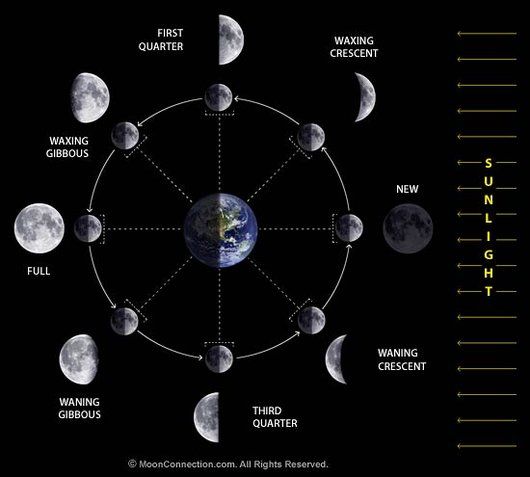 Many in the US are enjoying a lazy 4-day weekend as I write this. That being the case, I'll keep the feats relatively simple.
Many in the US are enjoying a lazy 4-day weekend as I write this. That being the case, I'll keep the feats relatively simple.
In this post, you'll find out how to easily give others a new perspective by looking at time and space in new ways!
EARTH PHASE FROM THE MOON: If you've practiced working out the moon phase for any date in your head, whether you do the full version, or just memorized how to do it for 1 particular year, this feat is surprisingly simple.
Once you've determined the phase of the moon on a given date, the phase of the Earth as seen from the moon will be exactly the opposite phase! If the moon, as seen from the Earth, is in a full moon, then the Earth, as viewed from the moon, will be a “New Earth” (the Earth will be unlit). If the moon is in a waxing gibbous phase (more than 50% lit, and getting brighter each night), then the Earth, as seen from the moon, will be in a waning crescent phase (the Earth will be less than 50% lit, and getting darker each night).
Why does it work out this way? Take a look at the moon phase diagram below. Pick a phase, and follow that phase's line from the Earth to the moon, and imagine extending it through the moon. Imagine yourself out in space, along that line, looking at the opposite side of the moon that everyone on Earth sees. It's not hard to understand that the moon on this side must be in the opposite phase. If one side is getting brighter, the other side must be getting darker, and vice-versa.
Now, imagine yourself on that same line, but now you're between the Earth and the moon, facing the Earth. The sun is far enough away (90+ million miles!) that it's going to be lighting the opposite side of the moon and the Earth in the same way.

Just as in the original feat, you can verify this with Wolfram Alpha. If someone asks for the moon phase for, say, December 10, 2014, you would use the standard feat to estimate that the moon would be 19 days old (18-20 days old, including the margin of error), so you'd know it's in a waning gibbous phase, which means the moon is more than 50% lit, and getting darker each night.
Conversely, the Earth, as viewed from the moon, must be in a waxing crescent phase, so the Earth is less than 50% lit, and getting brighter each night. Wolfram Alpha can verify this for you.
1 MILLION SECONDS AGO: When you hear large numbers tossed around, it's really hard to get a sense of scale. How big is something like 1 million? To put it into perspective, imagine we're talking about 1 million seconds. When was it 1 million seconds ago?
Determining this isn't hard, especially if you just want to give the correct date. 1 million seconds is roughly 11.5 days. You can work out in your head what day 12 days ago was, or just cheat and use Wolfram Alpha to find out. If your local time is 1:46 PM or before, 1 million seconds ago was 12 days ago. If your local time is 1:47 PM or after, 1 million seconds ago was 11 days ago.
I'm writing this paragraph on December 1st, 2013, at about 11:45 AM local time, so 1 million seconds ago was November 19th, 2013. If I'm asked this afternoon at, say, 3:30 PM when 1 million seconds ago was, I'd say it was November 20, 2013, instead, because that is after 1:47 PM.
If you're interested in giving the exact minute, take the current time, add 13 minutes, then add 10 hours. 1 million seconds before December 1st at 11:45 AM would be November 19th of the same year at 9:58 PM, because 11:45 AM plus 13 minutes is 11:58 AM, and 10 hours after that is 9:58 PM.
If you're challenged to work out the exact second it was 1 million seconds ago, add 13 minutes and 20 seconds before adding the 10 hours. On 1:46:40 PM local time on any given day, 1 million seconds ago was exactly midnight, heading into 11 days ago.
As always, people can verify your answer using Wolfram Alpha.
1 BILLION SECONDS AGO: Since we're talking about large numbers, many people don't realize the difference in scale between 1 million and 1 billion, so when was 1 billion seconds ago?
1 billion seconds is over 31 years ago, so don't try and work out the exact date in your head. For this one, just look it up in Wolfram Alpha. As I write this on December 1, 2013, 1 billion seconds ago was March 25, 1982.
Working out the exact time is even simpler for 1 billion seconds ago, as it happens. First, add 13 minutes (and 20 seconds, if desired), just as before, but subtract 2 hours instead of adding 10 hours. December 1, 2013 at 11:45 AM minus 1 billion seconds is March 25, 1982 at 9:58 AM. Yes, your calculations can be verified with Wolfram Alpha.
You can make older dates like this more vivid by looking up those days on Wolfram Alpha or Wikipedia's year pages. For example, just a quick scan of those pages, I can remember that Danica Patrick was born, the first computer virus was only 2 months old, and the Vietnam Veteran's Memorial in Washington, D.C. would be opened the next day for the very first time.
1 TRILLION SECONDS AGO: 1 trillion seconds ago is the easiest, because that was 31,689 years ago, before modern clocks or calendars existed. This is roughly around 30,000 BCE, so ideas like the bow and arrow were still new, and not a single person was living in Japan yet. Obviously, if you include this, it's more for the sense of scale as compared to 1 million and 1 billion seconds ago.
If you like more mind-blowing changes in perspective, check out my Astronomical Scale post, and be ready for even more surprises!
0
Time, Space, and Perspective
Published on Sunday, December 01, 2013 in calendar, fun, math, memory, mental math, psychology, self improvement, site features
Related Posts
Post Details
Posted by Pi Guy on Dec 1, 2013
Labels:
calendar,
fun,
math,
memory,
mental math,
psychology,
self improvement,
site features
Subscribe to:
Post Comments (Atom)




No Response to "Time, Space, and Perspective"
Post a Comment